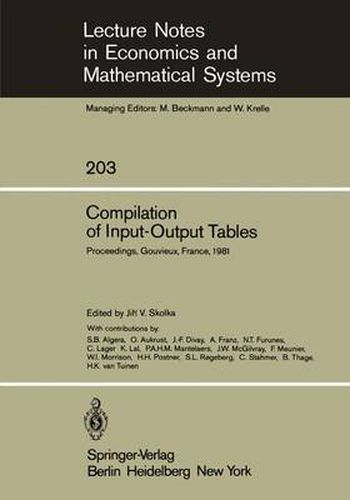Readings Newsletter
Become a Readings Member to make your shopping experience even easier.
Sign in or sign up for free!
You’re not far away from qualifying for FREE standard shipping within Australia
You’ve qualified for FREE standard shipping within Australia
The cart is loading…






This title is printed to order. This book may have been self-published. If so, we cannot guarantee the quality of the content. In the main most books will have gone through the editing process however some may not. We therefore suggest that you be aware of this before ordering this book. If in doubt check either the author or publisher’s details as we are unable to accept any returns unless they are faulty. Please contact us if you have any questions.
Those familiar with input-output analysis know well that compilation of input-output tables is a difficult statistical work. The very first input-output tables (e.g. such as those for the United States economy in 1919 and 1929 or for the Federal Republic of Germany in the fifties) were the results of applied economic research. But soon after, official statistical bodies, who understood that input-output tables consistent with national accounts can very much improve the quality of economic statistics, started systematic work in this field. It was also obvious that international exchange of experience can be useful. The two main internatio nal fora in which discussion of input-output compilation took place were the international input-out put conferences and United Nations bodies. Already at the First International Conference on Input-Output Techniques (Driebergen 1950) several authors analysed the relations between input-output tables and national accounts. The topic was also on the programme of the Second Conference (Varenna 1954). At the Third Conference (Geneva 1961) standardization of input-output statistics was a topic of a panel discussion of eight experts. The relevant papers, which are still of interest, can be found in published conference proceedings.
$9.00 standard shipping within Australia
FREE standard shipping within Australia for orders over $100.00
Express & International shipping calculated at checkout
This title is printed to order. This book may have been self-published. If so, we cannot guarantee the quality of the content. In the main most books will have gone through the editing process however some may not. We therefore suggest that you be aware of this before ordering this book. If in doubt check either the author or publisher’s details as we are unable to accept any returns unless they are faulty. Please contact us if you have any questions.
Those familiar with input-output analysis know well that compilation of input-output tables is a difficult statistical work. The very first input-output tables (e.g. such as those for the United States economy in 1919 and 1929 or for the Federal Republic of Germany in the fifties) were the results of applied economic research. But soon after, official statistical bodies, who understood that input-output tables consistent with national accounts can very much improve the quality of economic statistics, started systematic work in this field. It was also obvious that international exchange of experience can be useful. The two main internatio nal fora in which discussion of input-output compilation took place were the international input-out put conferences and United Nations bodies. Already at the First International Conference on Input-Output Techniques (Driebergen 1950) several authors analysed the relations between input-output tables and national accounts. The topic was also on the programme of the Second Conference (Varenna 1954). At the Third Conference (Geneva 1961) standardization of input-output statistics was a topic of a panel discussion of eight experts. The relevant papers, which are still of interest, can be found in published conference proceedings.